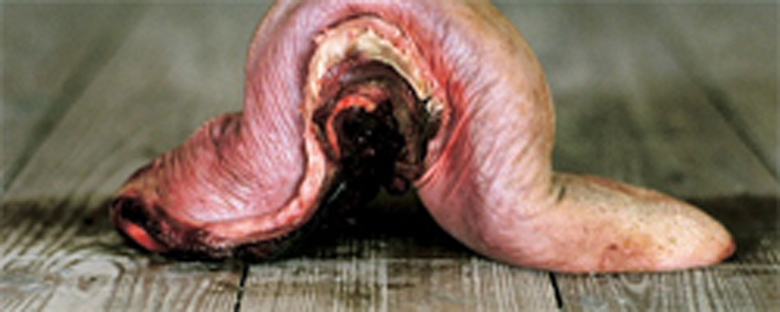Reviews
Sílení
Jan Svankmajer
Czech Republic / Slovakia, 2006
Credits
Review by Leo Goldsmith
Posted on 04 May 2006
Source Zeitgeist Films 35mm print
Related articles
Features: The 5th Annual Tribeca Film Festival
Reviews: Little Otik
Jan Svankmajer’s cinema is an explicitly, aggressively sensual one; his camera advocates a direct, tactile engagement with the world in all its oozing grotesquerie, rather than a smooth mythologization of it. In interviews, the filmmaker has expounded the virtues of an activce pursuit of repulsion — that which frightens, disgusts, or otherwise repels ought to be confronted, even embraced — and his films often draw the viewer into this exercise. No door opens without a creak, no furniture moves without scraping the floor, and above all, no food is consumed without a lapping of saliva or the churning sounds of mastication.
To this end, Lunacy, Svankmajer’s fifth feature film, is a forceful argument for the primacy of the body and its senses over the mind and rationality. Svankmajer makes his case not only through extensive polemical dialogue, but also in his film’s intrinsic structure. Dialogue is delivered directly into the camera (and so directly at the viewer), and each sound and image emphasizes the world’s proximity, its ugly tactility. Each aspect of the film is a confrontation of the senses, a shock delivered directly into the audience’s sensorium.
Like many of Svankmajer’s works, Lunacy is an adaptation, or more properly, a pair of adaptations. Splicing two stories of Edgar Allan Poe (“The Premature Burial” and “The System of Dr. Tarr and Dr. Fether”) with the libertine spirit and rhetoric of the Marquis de Sade, the film follows an ingenuous young man’s tutelage at the hands of a mysterious (and patently nutty) Marquis, who dresses in 18th century garb, rides in a horse-drawn carriage along the motorway, and has the habit of cackling maniacally. Once in the charge of this Marquis, the young Jean Berlot becomes aware that his host is not quite a Christian and enjoys holding bizarre, late-night rituals involving chained young maidens, bare-breasted nuns, and lustily eaten, crucifix-shaped chocolate cakes. When Jean protests at the Marquis’s blasphemous proceedings, the elder nobleman undertakes to show his young charge the error of his pious ways, both through thoughtful argument and some arduous hands-on demonstrations at the local lunatic asylum.
As with his other adaptations, the inspiration may be borrowed, but the product is wholly Svankmajer’s. Correlations with the filmmaker’s earlier work abound in the anachronistic Marquis and his disheveled chateau, the uncanny and unsettling combinations of live-action and various forms of animation, and the sense of dark, unconscious forces which govern all. Once inside the asylum, the Marquis demonstrates to Jean the potency of a “purgative therapy,” by which the patients exorcize their demons through total license (and licentiousness). Here, the lunatics run the asylum, tearing up feather pillows, sledding down grand staircases, and sating their many perverse appetites with abandon. Here, the body and senses are loosed of all their rational restraints and liberty is prized above all.
Interpolated between its dramatic scenes and rhetorical monologues are further allegorical testaments to the body’s irrepressible nature. These take the form of Svankmajer’s characteristic stop-motion vignettes, enacted by severed animal limbs and lumps of raw meat in intimate and veganism-inspiring closeup. As counterpoint and commentary to the film’s drama, these meat puppets — respiring hangar steaks; dislodged, yet still curious eyeballs; slithering brains; inchworming cows’ tongues — suggest not only humankind’s dumb fleshiness, but also its indomitable corporeal will. The lumps of meat fill cracks in masonry or, in an image that echoes the Brothers Quay, the innards of a clock; they run wild and simulate copulation and even puppet theater—seemingly nothing can contain them.
At the film’s outset, Svankmajer appears onscreen to introduce his film as “a horror film—with all the degeneracy peculiar to that genre.” And while the generic category may be debatable, the desire to make a film that is a fully sensual experience, one that gives free reign to our most perverse notions and appetites, is consistent with that genre’s aims. “It is not,” he further assures us, “a work of art.” It is, like so much of the surrealism of the former Czechoslovakia, an urgent and considered political statement. Throughout their careers, Svankmajer and his longtime collaborator and wife, the painter and author Eva Svankkmajerová, who died shortly after this film was completed, have practiced surrealism as an ethos, as a challenge to law, hypocrisy, and the regimes of realism. For them, surrealism is not a Dalí poster on a dorm-room wall or a psychedelic album cover, but a revolutionary statement, and, under state socialism, a punishable one.
Once order is restored to the asylum, and the ruthless, authoritarian doctors return to suppress the lunatics, it becomes clear that Svankmajer’s assertion of the importance of sensuality over reason is one of great social importance, and the Marquis de Sade becomes as great a figure of revolutionary purpose as he was in 18th century France. Similarly, Svankmajer’s film is a bold riposte, a lesson in extremity, and a reminder that art can be challenging, aggressive, hilarious, and repellent all at once. Surrealism, in other words, is not fantasy, but a sensibility, a way of life; it is an approach to the world, not a retreat from it.
We don’t do comments anymore, but you may contact us here or find us on Twitter or Facebook.



